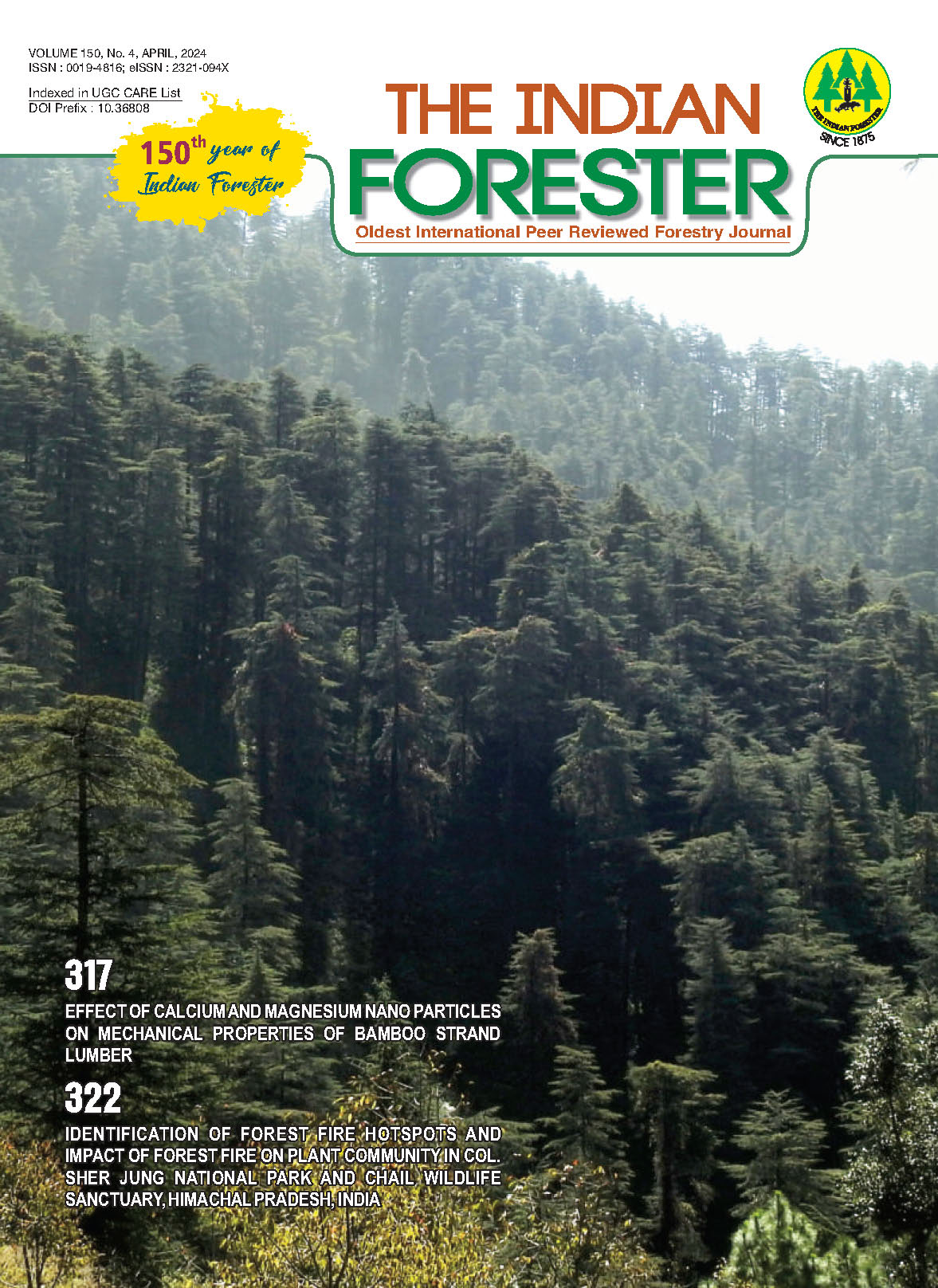Economic Analysis of Producing Quality Seedlings of Karanj (Pongamia pinnata L.) and Lakshmi Taru (Simarouba glauca D C.) with Different Growing Media under Shade-Net Conditions in South-Eastern Rajasthan
DOI:
https://doi.org/10.36808/if/2024/v150i4/169742Keywords:
Seedling, Growing Media, Benefit Cost Ratio, Karanj, Lakshmi Taru.Abstract
The present investigation was laid out in CRD with three replications during March, 2022 to October, 2022 at nursery block near herbal garden unit in Department of Silviculture and Agroforestry, College of Horticulture and Forestry, Jhalrapatan, Jhalawar, located at 23°4' to 24°52' N-Latitude and 75°29' to 76°56' E Longitude in South-Eastern Rajasthan. The experiment consisted of 21 treatment combinations of soil, sand, FYM and Vermi compost in different ratios. The study aimed to find out the best growing medium and economic analysis for quality seedling production of Karanj (Pongamia pinnata L.) and Lakshmi Taru (Simarouba glauca DC.). Seedlings were raised in the polybag of size 6†x 10†under green shade net nursery conditions. Different species exhibit different phenotypic and genotypic characteristics. Same can also be seen in preference of treatment combinations shown by species. Best BCR of Karanj and Lakshmi Taru seedlings was observed in treatment T0 Soil only (BCR 3.18) followed by T16 [Soil:Sand:Vermicompost (2:1:1) (BCR2.62)] and T11 [Soil:Sand:FYM (2:1:2) (BCR 1.20)] followed by T5 [Soil:FYM (1:2)(BCR1.19)] respectively. These two-treatment combination gave best results for BCR whereas maximum benefit-cost ratio of 3.18 and 1.20 for Karanj and Lakshmi Taru observed in T0 and T11 respectively. The results obtained from this study can be used to produce quality planting material of Karanj and Lakshmi Taru in the shortest possible time for farmers, nursery growers and plantation personals for roadside and energy plantations.References
Allen O.N. and Allen E.K. (1981). The Leguminosae. Wisconsin Press. Karmee, S.K. and Chadha, A. (2005). Preparation of biodiesel from crude oil of Pongamia pinnata. Bioresource technology, 96: 1425–1429.
Anon. (1966). Abridged glossary of technical terms (For use in Forest Colleges), F.R.I., Dehra Dun.
Attri M., Pandey S.B.S. and Jatav R. (2020). Economics of producing quality seedlings of important agroforestry species with different growing media under shade-net conditions in semi-arid region of Rajasthan. Journal of Pharmacognosy and Phytochemistry, 9(4): 545-54921.
Bhardwaj R.L. (2014). Effect of growing media on seed germination and seedling growth of papaya cv. red lady. African Journal of Plant Science, 8(4): 178-184.
Daniel J.N. (1997). Pongamia pinnata: a nitrogen fixing tree for oilseed. FACT 97-03. Forest Farm and Community Tree Network, USA.
Ephraim K., Rabo, Abubakar E. and Mazadu (2018). Economic Analysis of Seedlings Plant Productions in Nurseries within Bauchi Metropolis in Nigeria. International Journal of Forestry and Horticulture, 4(3): 15.
Joshi S. and Joshi S. (2002). Oil tree-Laxmitaru. University of Agricultural sciences, Bangalore and Indian council of Agricultural Research, New Delhi, India, 86.
Kulkarni K.V., Thawal D.W., Kharbade S.B., Shaikh A.A. and Jagtap K.B. (2017). Economics of Potted Gerbera with Different Growth Media under Protected Cultivation in Pune. International Journal of Agricultural Economics and Management, 7(1): 1-6.
Meera B., Kumar S. and Kalidar S.B. (2003). A review of the chemistry and biological activity of Pongamia pinnata. Journal of Medicinal and Aromatic Plant Sciences, 25(9): 441-465.
Muthu C., Ayyanar M., Raja N. and Ignacimuthu S. (2006). Medicinal plants used by traditional healers in Kancheepuram District of Tamil Nadu, India. Journal of Ethnobiology and ethnomedicine, 2(1): 1-10.
Punitha R., Vasudevan K. and Manoharan S. (2006). Effect of Pongamia pinnata flowers on blood glucose and oxidative stress in alloxan induced diabetic rats. Indian Journal of Pharmacology, 38(1): 62.
Syamasundar J. and Hiremath S. (2001). Simarouba oil tree. Booklet published by UAS, Bangalore in association with National Oilseeds and Vegetable oils Development Board (ICAR), Gurgoan.
Vivek and Gupta A.K. (2004). Biodiesel production from karanja oil. Journal of Scientific and Industrial Research, 63(5): 39- 47.
Wani A. and Panwar S. (2014). Effect of Organic production on growth and productivity of Sweet Potato (Ipomoea batatas L.) under Poplar based Agroforestry system. International Journal T of Advanced Research. 2 (12):229-232.
Downloads
Downloads
Published
How to Cite
Issue
Section
License
Unless otherwise stated, copyright or similar rights in all materials presented on the site, including graphical images, are owned by Indian Forester.





